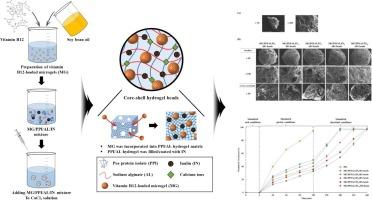Effect of inulin on structural, physicochemical, and in vitro gastrointestinal tract release properties of core-shell hydrogel beads as a delivery system for vitamin B12
IF 5.4
2区 医学
Q2 MATERIALS SCIENCE, BIOMATERIALS
引用次数: 0
Abstract
In this study, core-shell hydrogel beads were developed as a controlled-release delivery system for vitamin B12. Vitamin B12-loaded microgels (MG) were prepared using gellan gum (GG). Core-shell hydrogel beads were produced by incorporating MG into pea protein isolate (PPI) and sodium alginate (AL) matrix filled/coated with different concentrations (0 %, 1 %, 3 %, 5 %, and 10 %) of inulin (IN). Based on XRD analysis, MG was successfully incorporated into core-shell hydrogel beads. In FE-SEM and FT-IR analyses, the smoother surface and denser structure of the beads were observed as IN concentration increased due to hydrogen bonds between IN and the beads. The encapsulation efficiency increased from 68.64 % to 82.36 % as IN concentration increased from 0 % to 10 %, respectively. After exposure to simulated oral and gastric conditions, core-shell hydrogel beads exhibited a lower cumulative release than MG, and a more sustained release was observed as IN concentration increased in simulated intestinal conditions.

菊粉对作为维生素 B12 给药系统的核壳水凝胶珠的结构、理化和体外胃肠道释放特性的影响
本研究开发了核壳水凝胶珠,作为维生素 B12 的控释递送系统。使用结冷胶(GG)制备了维生素 B12 负载微凝胶(MG)。将 MG 加入填充/涂有不同浓度(0 %、1 %、3 %、5 % 和 10 %)菊粉(IN)的豌豆蛋白分离物(PPI)和海藻酸钠(AL)基质中,制成了核壳水凝胶珠。根据 XRD 分析,MG 成功地融入了核壳水凝胶珠中。在 FE-SEM 和 FT-IR 分析中,由于 IN 与珠子之间的氢键作用,随着 IN 浓度的增加,珠子的表面更加光滑,结构更加致密。随着 IN 浓度从 0% 增加到 10%,封装效率分别从 68.64% 增加到 82.36%。在模拟口腔和胃部条件下,核壳水凝胶珠的累积释放量低于 MG,而在模拟肠道条件下,随着 IN 浓度的增加,可观察到更持久的释放。
本文章由计算机程序翻译,如有差异,请以英文原文为准。
求助全文
约1分钟内获得全文
求助全文
来源期刊

ACS Biomaterials Science & Engineering
Materials Science-Biomaterials
CiteScore
10.30
自引率
3.40%
发文量
413
期刊介绍:
ACS Biomaterials Science & Engineering is the leading journal in the field of biomaterials, serving as an international forum for publishing cutting-edge research and innovative ideas on a broad range of topics:
Applications and Health – implantable tissues and devices, prosthesis, health risks, toxicology
Bio-interactions and Bio-compatibility – material-biology interactions, chemical/morphological/structural communication, mechanobiology, signaling and biological responses, immuno-engineering, calcification, coatings, corrosion and degradation of biomaterials and devices, biophysical regulation of cell functions
Characterization, Synthesis, and Modification – new biomaterials, bioinspired and biomimetic approaches to biomaterials, exploiting structural hierarchy and architectural control, combinatorial strategies for biomaterials discovery, genetic biomaterials design, synthetic biology, new composite systems, bionics, polymer synthesis
Controlled Release and Delivery Systems – biomaterial-based drug and gene delivery, bio-responsive delivery of regulatory molecules, pharmaceutical engineering
Healthcare Advances – clinical translation, regulatory issues, patient safety, emerging trends
Imaging and Diagnostics – imaging agents and probes, theranostics, biosensors, monitoring
Manufacturing and Technology – 3D printing, inks, organ-on-a-chip, bioreactor/perfusion systems, microdevices, BioMEMS, optics and electronics interfaces with biomaterials, systems integration
Modeling and Informatics Tools – scaling methods to guide biomaterial design, predictive algorithms for structure-function, biomechanics, integrating bioinformatics with biomaterials discovery, metabolomics in the context of biomaterials
Tissue Engineering and Regenerative Medicine – basic and applied studies, cell therapies, scaffolds, vascularization, bioartificial organs, transplantation and functionality, cellular agriculture
 求助内容:
求助内容: 应助结果提醒方式:
应助结果提醒方式:


